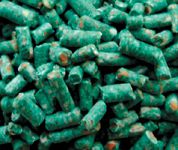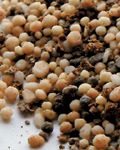Toxicology Brief: The 10 most common toxicoses in dogs
We compiled this list of the 10 most common hazards to dogs, based on the number of calls we have received at the aspca Animal Poison Control Center (APCC) between 2001 and 2005.
Dogs are usually exposed to potentially toxic household products and medications accidentally. But sometimes well-intentioned owners unknowingly give their dogs harmful products and medications. To help prepare you for patients with theses toxicoses, we compiled this list of the 10 most common hazards to dogs, based on the number of calls we have received at the ASPCA Animal Poison Control Center (APCC) between 2001 and 2005.1
Ibuprofen
Ibuprofen, a nonsteroidal anti-inflammatory drug with analgesic, anti-inflammatory, and antipyretic effects,2 is available in a variety of strengths. The most common over-the-counter strength is 200 mg, but the prescription-strength tablets can contain up to 800 mg ibuprofen. Ibuprofen has a narrow margin of safety in dogs, and acute toxicosis is common. Dogs are often exposed to ibuprofen accidentally when they chew on a medicine bottle, but sometimes owners give ibuprofen to their dogs intentionally for pain control.

1
Ibuprofen overdose can cause GI, renal, and central nervous system (CNS) effects. Doses of 25 mg/kg or more often lead to gastrointestinal (GI) problems and ulceration, manifested as vomiting, diarrhea, or abdominal pain. Doses approaching 175 mg/kg increase a dog's risk of developing acute renal failure,2 but older dogs or those with preexisting renal compromise may exhibit renal failure at lower doses. With doses greater than 400 mg/kg, CNS effects such as depression, seizures, and comas may occur.
Treatment for acute ibuprofen toxicosis includes inducing emesis, administering activated charcoal (multiple charcoal doses are indicated to reduce enterohepatic recirculation in dogs that have ingested high doses of ibuprofen) and GI protectants (H2-blockers, sucralfate, misoprostol), and inducing diuresis with intravenous fluids at twice the maintenance rate while monitoring renal function. With timely and appropriate treatment, most dogs are expected to have a positive outcome.
Chocolate
Chocolate contains two types of methylxanthine, theobromine and caffeine, with their amounts varying depending on the type of chocolate. For example, milk chocolate contains about 60 mg/oz methylxanthine, dark chocolate about 150 mg/oz, and baking chocolate about 450 mg/oz.3

2
Clinical signs of chocolate ingestion range from GI upset to cardiovascular effects (e.g. tachycardia, hypertension or hypotension, arrhythmias) to CNS signs (e.g. agitation, pacing, hyperactivity, tremors, seizures). The toxicity depends on the type of chocolate, the amount ingested, the size of the animal, and the animal's sensitivity to methylxanthines. Mild stimulation such as hyperactivity, agitation, and restlessness may occur in dogs ingesting around 20 mg/kg methylxanthine. Cardiotoxicosis may occur in dogs ingesting 40 mg/kg, and dogs ingesting more than 60 mg/kg may exhibit severe CNS signs, such as tremors and seizures.3 GI signs such as vomiting and diarrhea can occur with any amount because of chocolate's high fat and sugar content.
Treating chocolate ingestion includes inducing emesis or performing gastric lavage, administering activated charcoal (multiples doses are recommended with large ingestions), monitoring the patient's vital signs closely, and providing supportive care. Continuous electrocardiogram (ECG) monitoring is advisable in cases in which cardiotoxicosis is expected. Performing baseline serum chemistry profiles and monitoring electrolytes in symptomatic animals are also recommended. Dogs should be stabilized before you initiate decontamination procedures. Administer intravenous fluids to enhance methylxanthine excretion, beta-blockers (e.g. propranolol, metoprolol) to reduce tachycardia, and diazepam to control agitation and tremors. Methylxanthines can be reabsorbed from the bladder, so monitor urine output and consider placing a urinary catheter to keep the bladder empty. Signs can last 24 to 72 hours because of the long half-life of theobromine in dogs (17.5 hours vs. 4.5 hours for caffeine).3
Ant and roach baits
The product names may vary, and the containers may be referred to as chambers, discs, stations, systems, traps, baits, or trays, but most ant and roach baits use an attractant (often peanut butter), a sweetening agent, and bread. And while these baits once contained compounds that are relatively highly toxic to mammals (e.g. arsenic trioxide, lead arsenate), the most common insecticides used in ant and roach baits today are boric acid, avermectin, fipronil, hydramethylnon, propoxur, and sulfluramid.1

3
Because of the low concentration of the insecticide and the small size of the bait, serious toxicosis in mammalian pets ingesting the baits is not expected.4 In many instances, the risk of foreign body obstruction from the plastic or metal part of the container is of greater concern than the active ingredients. Signs of ingestion are usually limited to mild GI upset and do not require specific treatment.
Rodenticides
The three main types of rodenticides are those containing anticoagulants (warfarin, brodifacoum, diphacinone [also called diphenadione]), those containing bromethalin, and those containing cholecalciferol.

4
Anticoagulant rodenticides are probably the most commonly used rodenticides in the world. Ingesting an anticoagulant rodenticide can block vitamin K-dependent clotting factor synthesis by inhibiting the 2,3-epoxide reductase enzyme, which results in a coagulopathy three to five days after ingestion (possibly sooner in immature animals).5
Ingesting a bromethalin-containing rodenticide may cause vacuolization and severe spongiosis of the white matter within the CNS and cerebral edema.6 Bromethalin ingestion can cause signs ranging from tremors and seizures (convulsant syndrome) to weakness and paralysis (paralytic syndrome). Convulsant syndrome usually occurs at doses of 2.3 mg/kg and higher. Paralytic syndrome is more likely when a dog ingests a lower dose.6
Ingesting cholecalciferol-containing rodenticides can increase dogs' serum calcium and phosphorus concentrations, potentially leading to acute renal failure and tissue mineralization.7
Perform gastric decontamination procedures (induce emesis and administer activated charcoal with a cathartic) as soon as possible after any rodenticide ingestion. Do not induce emesis in symptomatic animals (e.g. bleeding or seizing animals).
Treat anticoagulant-rodenticide ingestion with vitamin K1 orally for 14 to 30 days, depending on the specific active ingredient. It is recommended to evaluate the one-stage prothrombin time at 48 hours after the last dose of vitamin K1. An alternative to treatment is to monitor the prothrombin time at 48 and 72 hours after ingestion, and if elevated, initiate vitamin K1 therapy.8 Animals that have developed a coagulopathy may require whole blood or plasma transfusion and oxygen. The prognosis for animals that have developed a coagulopathy is guarded and depends on the bleeding site.
Because no specific treatment for bromethalin toxicosis is available, aggressive decontamination is critical. If clinical signs develop, they are difficult to treat, and the patient's prognosis is guarded. Therapy is directed at resolving cerebral edema and addressing seizures, usually by administering corticosteroids, furosemide, mannitol, and diazepam. Since the cerebral edema from bromethalin toxicosis is intramyelinic,6 it does not respond well to standard therapy. Mannitol, corticosteroids, and furosemide may temporarily lower cerebrospinal fluid pressure, but signs often progress once these treatments are discontinued.
In rats, an extract of Ginkgo biloba was shown to reduce the development of cerebral edema and brain lipid peroxidation when administered orally immediately after gavage with a lethal dose of bromethalin.6 Whether G. biloba or its extracts would influence the development of clinical signs in dogs with bromethalin toxicosis is unknown, but you may wish to consider it in patients in which other options have been unsuccessful.
Treating cholecalciferol-containing rodenticide ingestion requires close monitoring of the serum calcium and phosphorus concentrations and the renal function parameters for 72 to 96 hours. If hyperphosphatemia or hypercalcemia occurs, perform saline diuresis, and administer corticosteroids, furosemide, or phosphate-binding agents. Salmon calcitonin or pamidronate may also be needed. Pamidronate, a bisphosphonate used in people to treat hypercalcemia of malignancy, is a preferred agent in treating cholecalciferol toxicosis.7 Although expensive, a single dose of pamidronate is often sufficient to lower calcium concentrations enough that the animal can be returned home with minimal additional treatment.
Acetaminophen
Acetaminophen is available as tablets, capsules, or liquids, either alone or combined with other compounds such as opioids, aspirin, caffeine, and antihistamines. Acetaminophen toxicosis can result in hepatotoxicosis, methemoglobinemia, and facial and paw edema.9 Some dogs have developed transient keratoconjunctivitis sicca after ingesting acetaminophen doses well below the amounts previously considered to be of concern.1 Hepatotoxicosis can occur with doses of 50 to 100 mg/kg, and methemoglobinemia may occur in up to 75% of dogs ingesting 200 mg/kg.10

5
To treat acetaminophen toxicosis, initiate gastric decontamination procedures, and then administer a 5% N-acetylcysteine (NAC) solution. Administer 140 mg/kg NAC orally as a loading dose, followed by 70 mg/kg every six hours for at least seven doses.9 Although NAC is not labeled for intravenous administration, it can be given intravenously in life-threatening situations by using a bacteriostatic filter (0.2 µm). Administer fluid therapy to maintain hydration; diuresis does not enhance acetaminophen elimination. Adjunctive therapies include administering ascorbic acid, which helps reduce methemoglobin to hemoglobin; cimetidine, which inhibits cytochrome P-450 oxidation in the liver and may help reduce acetaminophen metabolism; and S-adenosylmethionine in patients in which long-term treatment of hepatic injury is needed. Monitor serum chemistry profile parameters, and evaluate tear production and administer artificial tears and cyclosporine if needed.9 The facial and paw edema will resolve on its own, so corticosteroids and antihistamines are not indicated.
Pseudoephedrine-containing cold medications
Many cold medications contain pseudoephedrine, a sympathomimetic drug structurally similar to amphetamines. Pseudoephedrine ingestion can lead to dose-dependent stimulation of the cardiovascular system and the CNS. The most common clinical signs include agitation, hyperactivity, panting, hyperthermia, hypertension, tachycardia, head bobbing, or mydriasis. Ingesting as little as 10 to 12 mg/kg pseudoephedrine can cause life-threatening signs.11

6
Treatment includes gastric decontamination in asymptomatic animals, patient monitoring, and symptomatic care. Agitation and hyperactivity are best controlled with acepromazine; avoid diazepam because it may exacerbate the agitation. Administer phenobarbital or pentobarbital to control severe tremors and seizures, and give isoflurane in refractory cases. Fluid therapy enhances pseudoephedrine excretion and protects the kidneys from myoglobinuria, which can result from excessive shaking. Because of likely hypertension, do not exceed fluid rates of one and a half to two times the maintenance rate unless the dog is in shock or dehydrated. Closely monitor the heart rate and rhythm, and use beta-blockers, such as propranolol, if tachycardia is severe. Signs can persist for up to 72 hours.11
Thyroid hormones
Natural (desiccated thyroid) and synthetic (levothyroxine) derivatives of thyroid hormones are used to treat hypothyroidism in animals and people.

7
Dogs can maintain a remarkably normal physiologic state in the face of a massive L-thyroxine overdosage. Such resistance to developing thyrotoxicosis can be explained in part by pharmacokinetics, such as poor GI absorption, serum tri-iodothyronine (T3) and thyroxine (T4) being highly protein bound, alternative metabolic pathways, and greater potential for biliary excretion and fecal loss. In addition, certain organs (particularly the liver and kidneys) can concentrate thyroid hormones intracellularly, thereby rendering these hormones unavailable to bind to tissue receptors and induce a physiologic effect. Thus, the liver and kidneys can act as buffers by releasing small or large amounts of hormones, depending on what the body needs, back into the plasma. In an overdose situation, these buffer organs can concentrate the extra hormone and not release the already stored hormone.12
Dogs ingesting 0.2 mg/kg levothyroxine may develop mild signs, and dogs ingesting 1 mg/kg or more may need treatment. Hyperactivity and tachycardia are the most common signs of thyrotoxicosis.13
Initiate gastric decontamination procedures in patients that ingest a large dose, and monitor the patients' ECGs, blood pressures, and serum T4 concentrations. Treatment is symptomatic and supportive. Diazepam can be given to control hyperactivity, and beta-blockers can be given to control tachycardia.12
Bleach
Regular household bleaches contain 3% to 6% sodium hypochlorite; commercial bleaches are typically much more concentrated. Color-safe bleaches contain sodium peroxide, sodium perborates, or enzymatic detergents. Most household bleaches are mild to moderate irritants and are not associated with a marked degree of tissue destruction. Household bleaches can cause skin or eye irritation, mild oral or esophageal burns, or GI irritation.14 Commercial bleaches can be corrosive and lead to severe stomatitis, pharyngitis, esophagitis, or esophageal ulcerations. Inhalation exposure to bleach can cause respiratory irritation, coughing, and bronchospasm. More serious damage can occur when bleach is mixed with ammonia-containing agents, forming chloramine and chlorine gases. Inhaling these gases can lead to a chemical pneumonitis.

8
To treat dermal exposure, bathe the dog with mild dishwashing detergent. The preferred initial treatment with bleach ingestion is oral dilution with milk or water. Dilution is most effective if it is performed early. Emesis is contraindicated because of the irritating properties of household bleach and the potential corrosive effects of commercial bleaches. GI protectants such as sucralfate or H2-blockers can also be used to symptomatically treat bleach ingestion. Treating corrosive damage may also require pain medications, antibiotics, and nutritional support. Oxygen and bronchodilators may be needed to treat respiratory signs in cases of inhalation exposure.
Fertilizer
Fertilizer products generally contain varying amounts of nitrogen (N), phosphorus (P), and potassium (K) compounds. Product ingredients are often listed as N-P-K 10-8-8, where each number is the corresponding ingredient's concentration percentage. Fertilizer formulations include liquid, granular, and solid (e.g. stakes), and fertilizer additives may include herbicides, insecticides, fungicides, iron, copper, or zinc. Because fertilizers are usually a combination of ingredients, several toxic principles are possible. In general, the ingredients are poorly absorbed, and most of the signs are related to GI irritation.

9
Fertilizers have a wide margin of safety.15 GI signs such as vomiting, hypersalivation, diarrhea, or lethargy are common in dogs after ingesting fertilizers, especially ones with high percentages of phosphorus and potassium compounds. In most cases these signs are self-limiting and resolve within 12 to 24 hours. 15
Treat animals with GI signs supportively with antiemetics, fluids, and GI protectants. Address added insecticides or herbicides separately. Heavy metals, such as iron, are generally not bioavailable but can pose a hazard when dogs ingest large amounts.
Hydrocarbons
Hydrocarbons are in numerous products, including paints, varnishes, engine cleaners, furniture polish, lighter fluid, lamp oils, paint removers, and fuel oil (e.g. acetone, xylene, kerosene, gasoline, naphtha, mineral oil). GI signs such as vomiting and diarrhea are common in dogs ingesting hydrocarbons. Mild to moderate eye irritation and reversible ocular injury may occur after contact with most hydrocarbons.16 Acute but prolonged skin exposure to some hydrocarbons can result in dermal burns and, occasionally, systemic effects. Low-viscosity, highly volatile hydrocarbons (e.g. those found in kerosene, gasoline, liquid furniture polish) are aspiration hazards. Pulmonary damage, transient CNS depression or excitement, hypoxia, inflammation, and, potentially, secondary infection (pneumonia) can occur.16 Hepatic and renal damage have been reported from a percentage of both experimental and field cases of hydrocarbon poisoning. Some hydrocarbons are also apparently capable of sensitizing the myocardium to endogenous catecholamines, resulting in arrhythmias and even complete cardiovascular collapse.16
Because of the risk of aspiration, emesis is contraindicated in patients ingesting products containing hydrocarbons. Dilution can be recommended. To treat topical exposure, bathe the dog with a liquid dishwashing detergent. Flush the eyes copiously with saline in cases of ocular exposure. Closely monitor patients for aspiration pneumonia, particularly in vomiting dogs.16 Treatment is supportive and symptomatic .

10
"Toxicology Brief" was contributed by Irina Meadows, DVM, and Sharon Gwaltney-Brant, DVM, PhD, ASPCA Animal Poison Control Center, 1717 S. Philo Road, Suite 36, Urbana, IL 61802. The department editor is Petra A. Volmer, DVM, MS, DABVT, DABT, College of Veterinary Medicine, University of Illinois, Urbana, IL 61802.
REFERENCES
1. Antox [database]. Urbana, Ill: American Society for the Prevention of Cruelty to Animals National Animal Poison Control Center. Accessed 2005.
2. Dunayer E. Ibuprofen toxicosis in dogs, cats, and ferrets. Vet Med 2004;99:580-586.
3. Gwaltney-Brant S. Chocolate intoxication. Vet Med 2001;96:108-111.
4. Wismer T. Novel Insecticides. In: Plumlee KH, ed. Clinical veterinary toxicology. St. Louis, Mo: Mosby, 2003;183-186.
5. Dorman DC. Toxicology of selected pesticides, drugs, and chemicals. Anticoagulant, cholecalciferol, and bromethalin-based rodenticides. Vet Clin North Am Small Anim Pract 1990;20:339-352.
6. Dorman DC, Cote LM, Buck WB. Effects of an extract of Gingko biloba on bromethalin-induced cerebral lipid peroxidation and edema in rats. Am J Vet Res 1992;53:138-142.
7. Morrow C. Cholecalciferol poisoning. Vet Med 2001;96:905-911.
8. Merola V. Anticoagulant rodenticides: deadly for pests, dangerous for pets. Vet Med 2002;97:716-727.
9. Sellon RK. Acetaminophen. In: Peterson ME, Talcott PA, eds. Small animal toxicology. Philadelphia, Pa: WB Saunders Co, 2001;388-395.
10. Beasley VR, Dorman DC, Fikes JD, et al. A systems affected approach to veterinary toxicology. Urbana, Ill: University of Illinois Press, 1997;178-180.
11. Means C. Decongestants. In: Plumlee KH, ed. Clinical veterinary toxicology. St. Louis, Mo: Mosby, 2003;309-311.
12. DeClementi Safrit C. Acute thyroid hormone supplement overdosage. Vet Med 2001;96:424-430.
13. Hansen SR, Timmons SP, Dorman DC. Acute overdose of levothyroxine in a dog. J Am Vet Med Assoc 1992;200:1512-1514.
14. Kore AM. Common indoor toxicants: bleaches. In: Peterson ME, Talcott PA, eds. Small animal toxicology. Philadelphia, Pa: WB Saunders Co, 2001;161-162.
15. Albretsen JC. Fertilizers. In: Plumlee KH, ed. Clinical veterinary toxicology. St. Louis, Mo: Mosby, 2003;154-155.
16. Raisbeck MF. Petroleum hydrocarbons. In: Peterson ME, Talcott PA, eds. Small animal toxicology. Philadelphia, Pa: WB Saunders Co, 2001;666-676.










